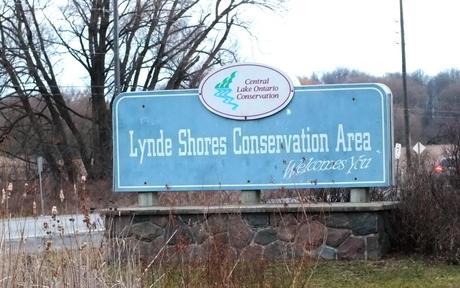
On an unseasonably warm January day, Bob and I needed some exercise so drove out to the Lynde Shores Conservation Area in Whitby to do some birdwatching. We had only been there once before, when cycling a couple of summers ago.
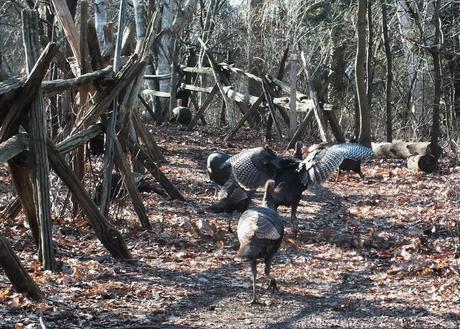
No sooner had we entered the grounds than a huge flock of eastern wild turkeys (Meleagris gallopavo) were found clogging the walkway of the Bird Feeding Trail. A frequent visitor to the conservation area said that she had never seen so many wild turkeys at this location.
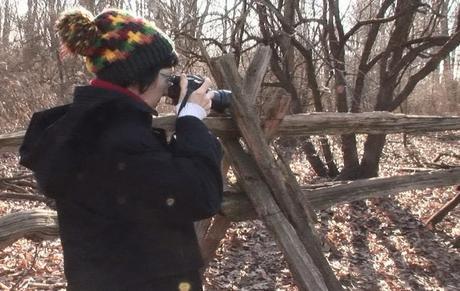
While I busied myself taking photographs, the turkeys scrounged for remnants of bird food that had been provided by generous bird lovers. Quite vocal in their attempts to outdo one another, the turkeys provided a constant backdrop of squeaks, gobbles and other unusual noises.
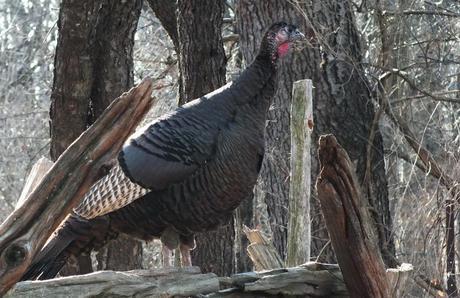
Only on the Bird Feeding Trail have the Conservation Authority defined the walkway with a cedar rail fence. The turkeys took advantage of the rails to survey their surroundings, and bird watchers carefully deposited birdseed onto the rails to entice the many chickadees and nuthatches into ever closer proximity.
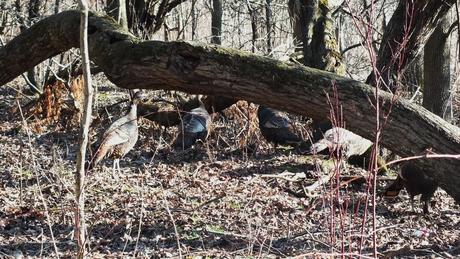
The conservation area is made up of a variety of natural landscapes, so the turkeys can quite easily disappear into the underbrush, as seen here.
That point comes home in this video that Bob filmed of the wild turkeys.
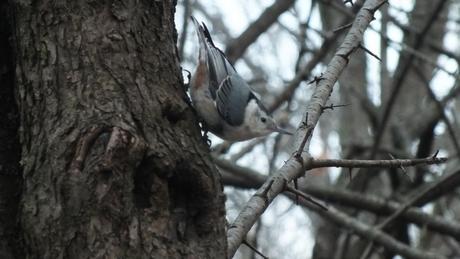
We saw numerous White-breasted Nuthatches (Sitta carolinensis) in the trees along the trail, obviously attracted by the availability of bird food. As with all nuthatches, they move down the tree trunk head first. This female can be identified by the chestnut-colored feathers on her lower rear.
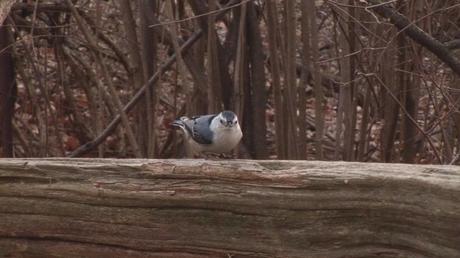
The White-breasted Nuthatches were even confident enough to snatch up seeds placed on the cedar rail fence.
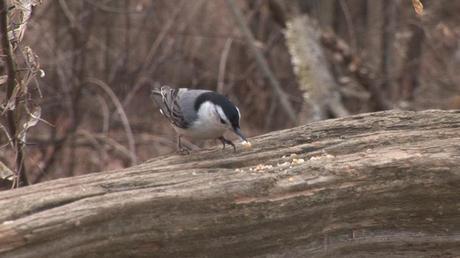
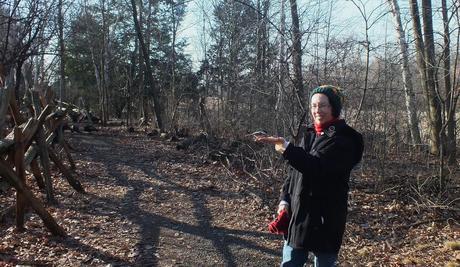
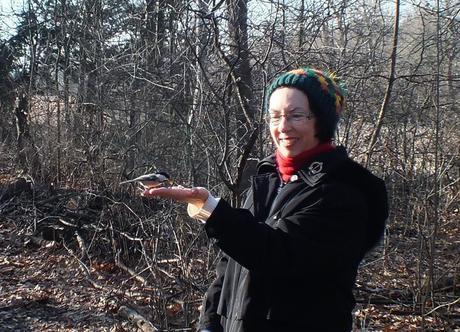
I haven’t fed chickadees out of my hand since I was a young girl. This was a nice chance to get a very close look at these cheerful little birds. The Black-capped Chickadees (Poecile atricapillus) vocalize with the familiar chick-a-dee-dee-dee call.
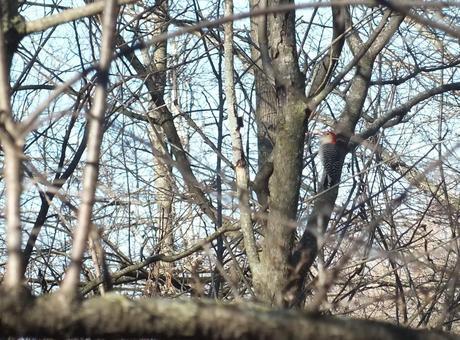
Keeping an eye on the website for local bird sightings alerted us to the presence of a Red-bellied Woodpecker (Melanerpes carolinus) at the Lynde Shores Conservation Area. That is why we went there on this day. I was thrilled to catch a quick glimpse of one of these woodpeckers as it made off with a peanut in the shell.
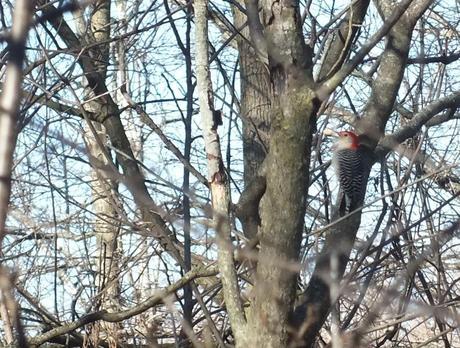
The range of the Red-bellied Woodpecker typically extends to the northern edge of Lake Ontario, but with the effects of climate change, they are being sighted further north every year. In this photo, the red belly of the male woodpecker is not visible.
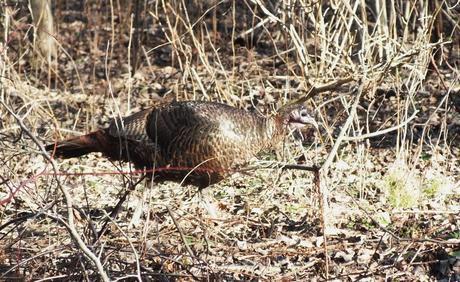
Throughout the afternoon, the wild turkeys were never far from view as they wove through the forest and crisscrossed the walking trails. Although native to North America, the Wild Turkey got its name due to the trade routes in place during the 16th Century. The major trade route from the Americas and Asia required goods to go through Constantinople in Turkey en route to Britain. The British at the time, therefore, associated the Wild Turkey with the country Turkey and the name stuck.
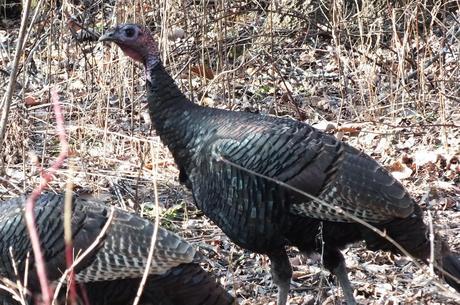
The body feathers are generally blackish and dark brown with a coppery sheen that becomes more complex in adult males. Their plumage is quite resplendent in shades of iridescent gold, bronze, shades of red, purple and teal when illuminated by the sun’s rays. The males are substantially larger than the females. We also happened upon a group of Wild Turkeys near Oxtongue Lake, Ontario
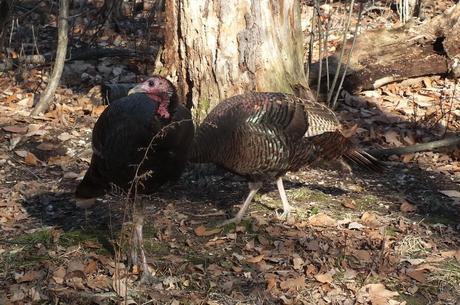
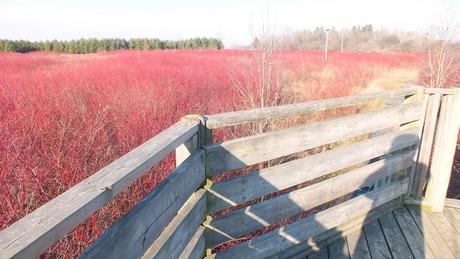
Whoever said that the landscape in winter is dull has never seen the beauty of Red Osier Dogwood when growing en masse. When viewed from an elevated observation point, the marshland spread before us in a sea of red.
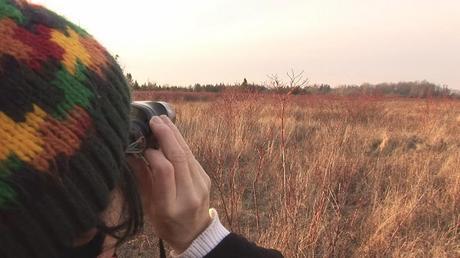
We knew that White-tailed deer live in the conservation area, having seen scat and evidence of the deer browsing on the Red Osier Dogwood. Blunt ends of the tender stalks showed white where the deer had nipped them off. Scanning the horizon soon revealed a few of the deer, but they were very difficult to pick out.
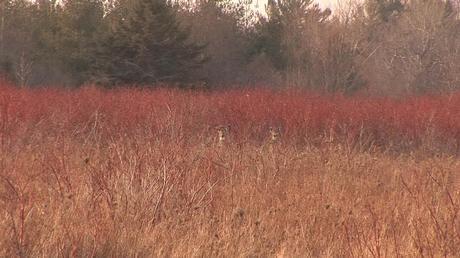
Can you see the two deer standing stalk still in the tall brown grass?
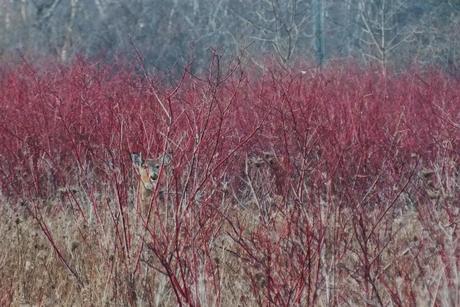

Bob tried to be circumspect as he edged ever closer to the two deer. When he finally had an unobstructed view, he realized that there were actually 6 deer in the group. The alarm went up, and they scattered like leaves on the wind, white tails bobbing a warning for all deer to see.
In this video, you get a chance to see the world of the deer underscored by the sounds of Canada Geese overhead.
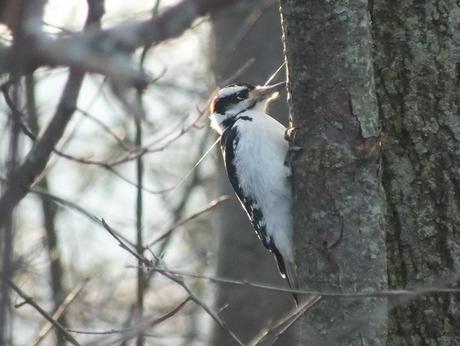
The hiking trail of the conservation area leads visitors towards the shore of Lake Ontario, but en route, it follows along the edge of a forested area. Herein, Bob and I took notice of a male Hairy Woodpecker (Picoides villosus) totally engrossed in the job of finding something to eat.
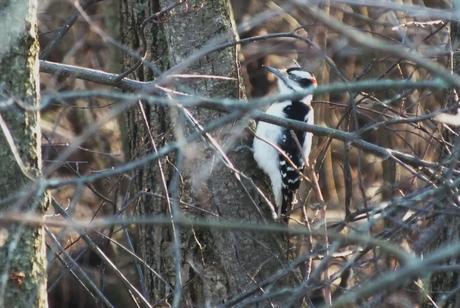
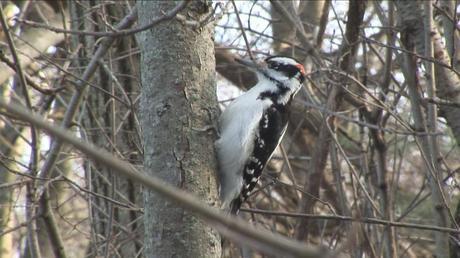
Hairy Woodpeckers maintain a stiff, upright posture as they move up and down tree trunks in search of a morsel.
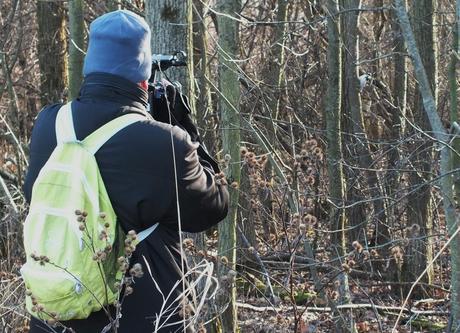
Because Hairy Woodpeckers are more shy and skittish than other woodpeckers, Bob had to remain a fair distance from this bird as it worked the trees.
In this video, you get to see both the Hairy and Downy woodpeckers that we saw on our hike.
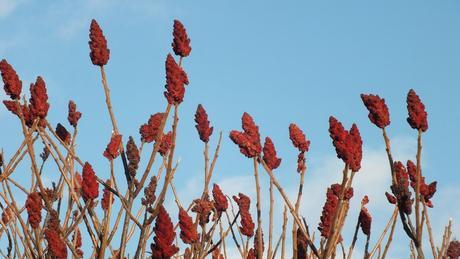
A thicket of Staghorn Sumac provided a vibrant burst of color and enchanted me as I walked beneath the thicket. Contrasted against the deep blue sky, the conical fruits of the plant brightened the dull browns and greys of the surrounding flatland.
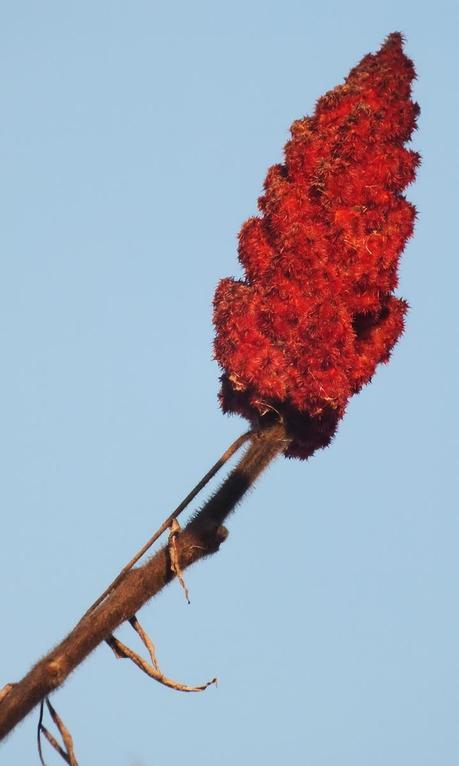
A radiant spire of Staghorn Sumac defies the cold winter winds…
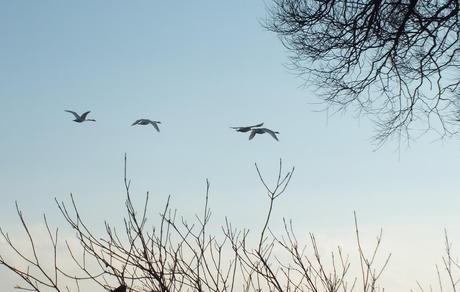
When 4 Mute Swans (Cggnus olor) took to the air in the distance, we knew that we were nearing the shore of Lake Ontario.

Just offshore from a strategically-placed park bench were 4 more Mute Swans bobbing on the waves. You would think it was a warm summer’s day.

Mute Swans can be differentiated from Trumpeter Swans because of their orange beaks and black basal knob just above the beak. They have earned the name Mute Swans because they are generally silent. They lack the loud discernible calls often characteristic of other bird species.
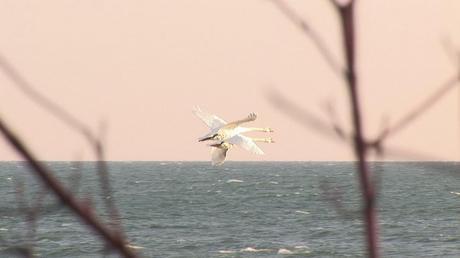
When the swans took to the air, Bob and I continued along the walking trail back towards the main gate. We were anxious to see if the Red-bellied Woodpecker would show itself again.
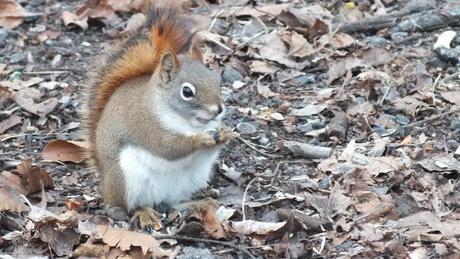
Because of the plentiful food and ideal surroundings, the forests of the conservation area have a healthy population of black, gray and red squirrels. This rotund little rodent was keen to eat even more sunflower seeds.
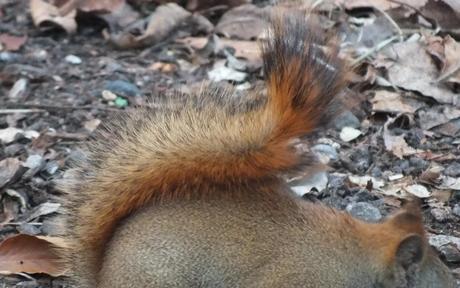
The American Red Squirrel (Tamiasciurus hudsonicus) is also called the chickaree or the pine squirrel. The bushy red tail of the Red Squirrel is used to maintain balance while the squirrel leaps from branch to branch in the treetops. When the animal is in repose, the tail is laid up over its back.
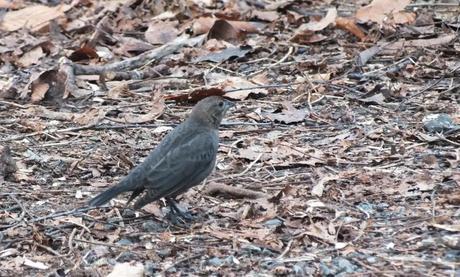
Once back in the area where we first saw the Red-bellied Woodpecker, Bob and I scanned the trees very carefully for any flash of red. The only birds we saw at that late point in the afternoon were some Brown-headed Cowbirds (Molothrus ater). They blended in well with the brown and gray leaves on the ground.
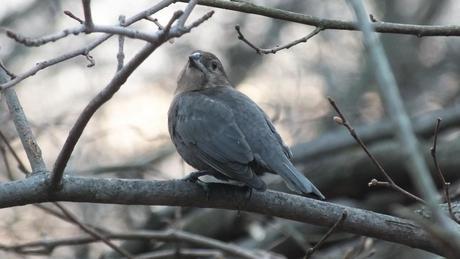
This female Brown-headed Cowbird was almost invisible in amongst the branches of a low bush. She can be distinguished by the finch-like head and beak.
In this video that Bob filmed, you get a chance to see just how well the Brown-headed Cowbird blends in with the branches. Notice that it walks around with its tail in the air and its wings held to the side.

Even though we didn’t catch sight of the Red-bellied Woodpecker for a second time that day, Bob and I were quite entertained by the Downy Woodpeckers (Picoides pubescens) making this forest their home. Down low…up high…on fallen logs or climbing the side of a tree, they were everywhere. This male Downy Woodpecker is about half the size of his larger cousin, the Hairy Woodpecker, and has a shorter beak.
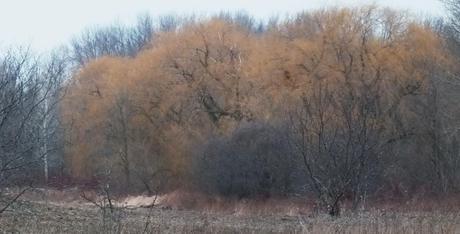
With the afternoon light fading, a warm glow in a distant field was seen in the mellow yellow of this weeping willow.
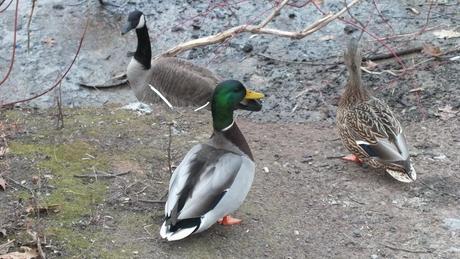
Searching the waterways next to the main gate for signs of the resident muskrats and mink turned up neither of these animals, but we were kept company by many resplendent mallard ducks (Anas platyrhynchos) and Canada Geese. They were looking for more handouts, but we were fresh out.
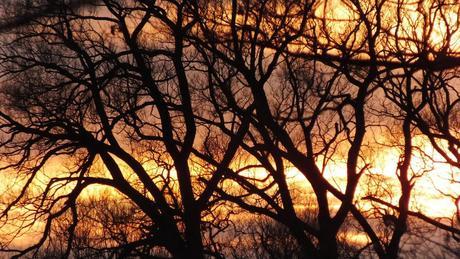
As we prepared to leave for home, the setting sun threw the nearby trees into stark silhouette against the brilliant western sky. The horizon was ablaze with shimmering golds, yellows and reds, and reminded us of similar sunsets we had been witness to on the veldt in South Africa.
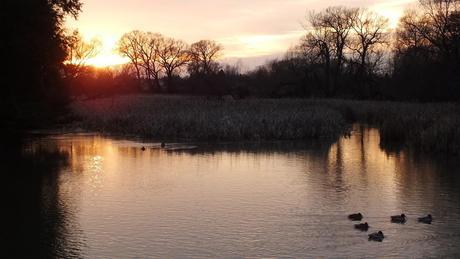
Darkness settled over the Lynde Shores Conservation Area like a warm blanket as the beasts and fowl called it a day. Ducks glided silently towards the shore, barely disturbing the stillness of the water, and the world seemed at peace. .
Frame To Frame.ca

